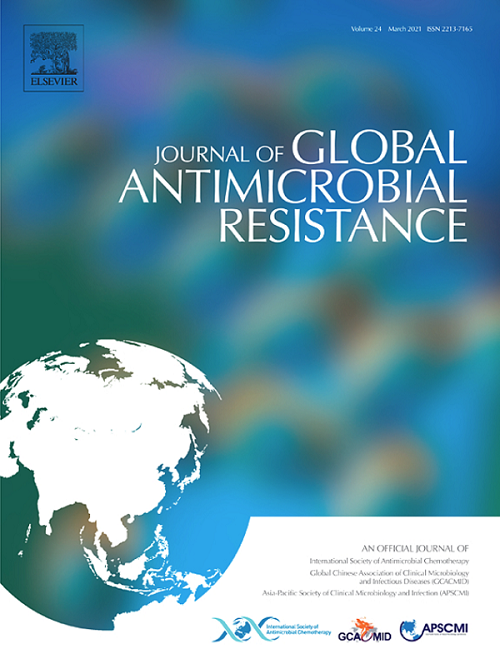依拉瓦环素和替加环素对耐碳青霉烯鲍曼不动杆菌体外活性的比较:来自全基因组测序分析的见解。
IF 3.2
3区 医学
Q2 INFECTIOUS DISEASES
引用次数: 0
摘要
目的:Eravacycline (ERV)是一种新型四环素类抗生素,在欧洲和美国已被证明对耐碳青霉烯鲍曼不动杆菌(CRAB)有效,但尚未在新加坡进行评估。本研究的目的是评估ERV对新加坡临床分离株的活性,并研究这些分离株的遗传谱,通过全基因组测序(WGS)分析探索新的潜在ERV耐药机制。方法:对2012 ~ 2021年在新加坡总医院(SGH)采集的300株螃蟹临床分离株进行ERV及其他抗生素的敏感性检测。测定了这些分离株的基因组图谱,包括序列型(ST)、抗菌素耐药性(AMR)和毒力因子(VF)基因。研究人员进一步分析了具有高ERV mic的分离株,以确定与降低ERV易感性相关的潜在基因突变。结果:ERV体外抗螃蟹活性强,MIC90为2µg/mL。WGS分析显示,300株螃蟹分离株属于23个STs,其中ST2为优势群体,经常携带内在blaoxa型β-内酰胺酶和四环素类外排泵(tet(B))。VF分析显示了广泛的遗传多样性,变异超出了简单的存在/缺失模式。值得注意的是,ERV耐药性的出现(MIC升高,MIC > MIC90)被检测到,高MIC分离株的遗传分析发现了抗性-结瘤-细胞分裂(RND)外排泵基因(adeABC, adeFGH和adeIJK)及其调控元件(adeS/R和adeL/N)的新突变。结论:在新加坡,ERV是一种很有前景的治疗螃蟹感染的选择。然而,由新的基因突变介导的耐药性的出现突出了持续监测和进一步调查的必要性。本文章由计算机程序翻译,如有差异,请以英文原文为准。
Comparative in vitro activities of eravacycline and tigecycline against carbapenem-resistant Acinetobacter baumannii: Insights from whole genome sequencing analysis
Objectives
Eravacycline (ERV), a novel tetracycline-class antibiotic, has demonstrated efficacy against carbapenem-resistant Acinetobacter baumannii (CRAB) in Europe and the United States but has not been evaluated in Singapore. The objectives of this study are to evaluate the activity of ERV against CRAB clinical isolates from Singapore and to investigate the genetic profiles of these isolates, exploring novel potential ERV resistance mechanisms through whole genome sequencing (WGS) analysis.
Methods
Three hundred CRAB clinical isolates collected from Singapore General Hospital (SGH) between 2012 and 2021 were tested for their susceptibility to ERV and other antibiotics. The genomic profile, including sequence type (ST), antimicrobial resistance, and virulence factor (VF) genes of these isolates, was determined. Isolates exhibiting high ERV minimum inhibitory concentrations (MICs) were further analysed to identify potential genetic mutations associated with reducing ERV susceptibility.
Results
ERV demonstrated strong in vitro activity against CRAB, with an MIC90 of 2 µg/mL. WGS analysis revealed that the 300 CRAB isolates belonged to 23 STs, with ST2 being the predominant population and frequently harbouring intrinsic blaOXA-type β-lactamases and tetracycline-class efflux pumps (tet(B)). VF analysis shows extensive genetic diversity, with variations beyond simple presence/absence patterns. Notably, the emergence of ERV resistance (elevated MIC, and MIC > MIC90) was detected, and genetic analysis of high-MIC isolates identified novel mutations in the resistance-nodulation-cell division (RND) efflux pump genes (adeABC, adeFGH, and adeIJK) and their regulatory elements (adeS/R and adeL/N).
Conclusions
ERV is a promising therapeutic option for managing CRAB infections in Singapore. However, the emergence of resistance mediated by novel genetic mutations highlights the need for continuous surveillance and further investigation.
© 2025 The Author(s). Published by Elsevier Ltd on behalf of International Society for Antimicrobial Chemotherapy.
求助全文
通过发布文献求助,成功后即可免费获取论文全文。
去求助
来源期刊

Journal of global antimicrobial resistance
INFECTIOUS DISEASES-PHARMACOLOGY & PHARMACY
CiteScore
8.70
自引率
2.20%
发文量
285
审稿时长
34 weeks
期刊介绍:
The Journal of Global Antimicrobial Resistance (JGAR) is a quarterly online journal run by an international Editorial Board that focuses on the global spread of antibiotic-resistant microbes.
JGAR is a dedicated journal for all professionals working in research, health care, the environment and animal infection control, aiming to track the resistance threat worldwide and provides a single voice devoted to antimicrobial resistance (AMR).
Featuring peer-reviewed and up to date research articles, reviews, short notes and hot topics JGAR covers the key topics related to antibacterial, antiviral, antifungal and antiparasitic resistance.
 求助内容:
求助内容: 应助结果提醒方式:
应助结果提醒方式:


